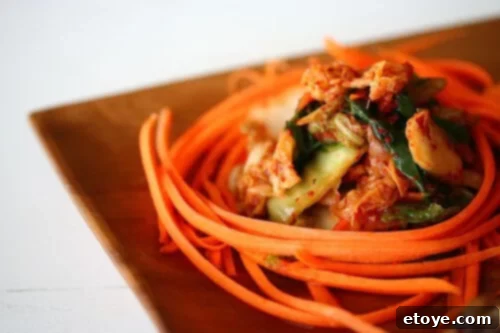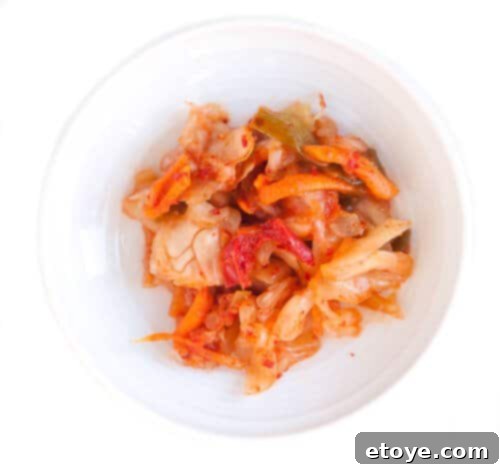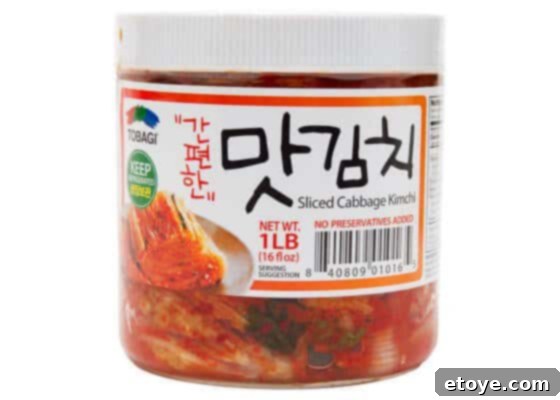Ultimate Guide to Kimchi Storage: How Long Does Kimchi Last and How to Keep it Fresh?
Discovering a passion for kimchi, whether you’ve bought a generous jar or meticulously crafted a homemade batch, often leads to one common question: “How long can I truly enjoy this fermented delight before it loses its vibrant flavor and texture?” This comprehensive guide is designed to transform you from a kimchi connoisseur into a kimchi storage master, ensuring every bite is as delicious as the first. We’ll explore the fascinating world of kimchi’s shelf life, delve into its numerous health benefits, and arm you with expert tips to maximize its freshness, from your refrigerator to your freezer.

How Long Does Kimchi Last? Unraveling Its Shelf Life
The lifespan of kimchi is a dynamic journey, heavily influenced by its storage environment. Understanding these timelines is key to enjoying your kimchi at its peak flavor and texture.
At Room Temperature: The Initial Fermentation Phase
Initially, kimchi undergoes its primary fermentation at room temperature for a few days to a week. Once this initial fermentation is complete and the kimchi is opened or stored, leaving it at room temperature for extended periods is generally not recommended. An opened container of kimchi left on the counter will typically last only about 1 week before it becomes overly sour and loses its desirable texture. While it’s safe to consume during this short window, its quality rapidly declines.
In the Refrigerator: The Long-Term Preservation Zone
Refrigeration significantly extends kimchi’s shelf life, slowing down the fermentation process considerably. When stored properly in the fridge, kimchi can last anywhere from 3 to 6 months, and sometimes even longer, depending on its initial freshness and preparation.
- Early Stages (1-3 months): During this period, kimchi is often at its crunchiest and mildest, offering a perfect balance of tangy, spicy, and savory notes. Many prefer kimchi during this phase for eating raw or as a fresh side dish (banchan).
- Mid to Late Stages (3-6+ months): As kimchi ages in the fridge, it continues to ferment, becoming progressively more sour and developing a softer texture. The beneficial lactic acid bacteria thrive, intensifying its characteristic pungent aroma and deep umami flavors. While some might find it too sour or mushy for raw consumption, this aged kimchi is highly prized for cooking, adding incredible depth to stews, fried rice, and soups.
The “sweet spot” for kimchi really depends on individual preference. If you enjoy a milder, crisper bite, aim to consume it within the first few months. If you appreciate the complex, deeply fermented flavors, older kimchi will be a culinary delight, especially in cooked dishes.

What is Kimchi? A Culinary and Cultural Icon
Kimchi is far more than just a fermented vegetable dish; it’s a cornerstone of Korean cuisine and a vibrant symbol of its rich cultural heritage. At its essence, kimchi is a traditional Korean side dish made from salted and fermented vegetables, most commonly napa cabbage and Korean radish, with a wide assortment of seasonings including gochugaru (chili powder), garlic, ginger, scallions, and jeotgal (salted seafood). The magic of kimchi lies in its fermentation process, which not only preserves the vegetables but also transforms their flavors into a complex symphony of tangy, spicy, savory, and umami notes.
A Glimpse into Kimchi’s Storied History
The origins of kimchi trace back centuries, born out of the necessity to preserve food during harsh Korean winters. Before the advent of refrigeration, fermentation was a crucial method for ensuring a continuous supply of nutrient-rich vegetables. Early forms of kimchi were simpler, often just salted vegetables. Over time, with the introduction of chili peppers to Korea in the 17th century, the iconic spicy red kimchi we know today began to take shape. This evolution cemented kimchi’s role not just as a survival food, but as an indispensable part of daily meals and communal gatherings, reflecting the ingenuity and resilience of Korean culinary traditions.
The Art of Fermentation: A Living Food
The characteristic tang and depth of flavor in kimchi come from lactic acid bacteria, similar to those found in yogurt and sauerkraut. These beneficial microorganisms break down sugars in the vegetables, producing lactic acid, which acts as a natural preservative and gives kimchi its signature sourness. This process also creates a rich ecosystem of probiotics, contributing significantly to its reputation as a health-promoting food.
Diversity in Every Bite: Types of Kimchi
While napa cabbage kimchi (Baechu Kimchi) is the most famous variety, the world of kimchi is incredibly diverse. There are hundreds of variations, each with its unique ingredients, regional preparations, and flavor profiles. Some popular types include:
- Kkakdugi: Cubed radish kimchi, known for its crisp texture and refreshing taste.
- Oi Sobagi: Cucumber kimchi, often stuffed with a spicy filling, perfect for warmer months.
- Chonggak Kimchi: Ponytail radish kimchi, using young, whole radishes with their greens.
- Geotjeori: Fresh, unfermented kimchi, typically eaten immediately after preparation, offering a brighter, less sour flavor.
This rich variety ensures there’s a kimchi for every palate and every occasion, from a fiery kick to a subtly refreshing crunch.

The Remarkable Health Benefits of Kimchi
Beyond its incredible flavor, kimchi is celebrated globally for its impressive array of health benefits. Often referred to as a superfood, its nutritional profile and probiotic content make it a powerhouse for wellness.
Gut Health and Digestion
- Rich in Probiotics: Kimchi is teeming with beneficial bacteria, primarily Lactobacillus species, which are vital for a healthy gut microbiome. These probiotics help balance gut flora, aiding in the breakdown of food and promoting efficient nutrient absorption.
- Aids Digestion: By enhancing the diversity and activity of gut bacteria, kimchi can alleviate common digestive issues like bloating, constipation, and indigestion. A healthy gut is often linked to overall well-being.
Immune System Boost
- Packed with Vitamins and Minerals: Kimchi is a good source of vitamin C, an essential antioxidant that supports immune function. It also provides vitamin A, B vitamins, and minerals like potassium, calcium, and iron, all contributing to a robust immune system.
- Antioxidant Properties: The array of ingredients in kimchi, including garlic, ginger, and chili peppers, are rich in antioxidants that combat free radicals, reduce oxidative stress, and protect cells from damage.
Weight Management and Cardiovascular Health
- Low-Calorie and Low-Fat Content: Kimchi is naturally low in calories and fat, making it an excellent addition to a balanced diet for those mindful of their weight.
- Fiber-Rich: The fermented vegetables provide dietary fiber, which promotes satiety and aids in healthy digestion, further supporting weight management goals.
- Potential Cholesterol Reduction: Some studies suggest that certain compounds in kimchi, like allicin from garlic, may help lower cholesterol levels and improve cardiovascular health.
Regular consumption of kimchi can contribute to a healthier lifestyle, supporting everything from gut balance to immune resilience, making it much more than just a tasty side dish.

Factors That Affect the Shelf Life of Kimchi
While kimchi is renowned for its longevity, several key factors play a crucial role in determining how long your batch will remain fresh and flavorful. Understanding these influences can help you make informed storage decisions.
1. The Type and Preparation of Kimchi
- Homemade vs. Store-Bought: Homemade kimchi, especially traditional recipes, often contains fewer preservatives (or none at all) compared to commercially produced varieties. While this can mean a shorter shelf life for homemade versions, their flavor profile is often richer and more authentic. Store-bought kimchi, particularly pasteurized types, might last longer but can lack the full spectrum of live probiotics.
- Fermentation Level: Freshly made or “geotjeori” (unfermented kimchi) has a shorter shelf life than fully fermented kimchi, which has developed a protective acidic environment.
2. Ingredients and Their Quality
- Vegetables: The type and freshness of vegetables used impact shelf life. Firmer vegetables like napa cabbage and radish tend to hold up longer than softer ingredients.
- Salt Content: Salt is a primary preservative in kimchi. Adequate salting is crucial for inhibiting harmful bacteria and promoting the growth of beneficial lactic acid bacteria. Too little salt can lead to spoilage.
- Other Additives: Ingredients like fish sauce, shrimp paste, or sugar can influence the fermentation rate and, consequently, the shelf life. While essential for flavor, their quantities need to be balanced.
3. Storage Methods and Environment
- Airtight Containers: Exposure to air is one of the biggest enemies of kimchi’s longevity. An airtight container minimizes oxidation, prevents the introduction of unwanted microbes, and keeps kimchi from drying out.
- Consistent Temperature: Fluctuations in temperature can accelerate fermentation and spoilage. A consistently cool environment, like a refrigerator (ideally between 34-38°F or 1-3°C), is paramount.
- Light Exposure: Direct sunlight or strong artificial light can also negatively impact kimchi, potentially altering its color, flavor, and accelerating degradation. Store it in a dark place within your fridge.
4. Hygiene and Cross-Contamination
- Clean Utensils: Always use clean utensils when handling kimchi. Introducing food particles or bacteria from other sources can contaminate your kimchi and drastically shorten its shelf life.
- Handling Frequency: Every time you open the container and take out kimchi, you expose it to air and potential contaminants. Minimize unnecessary opening.
5. Use-by Dates (for Commercial Kimchi)
For store-bought kimchi, always pay attention to the “best by” or “expiration” dates provided by the manufacturer. While fermented foods can often be consumed safely past these dates, they serve as a guide for optimal quality and flavor.

Signs of Spoilage: When to Bid Your Kimchi Adieu
Even with the best storage practices, kimchi eventually reaches the end of its enjoyable life. Knowing the telltale signs of spoilage is essential for food safety and preventing unpleasant culinary experiences.
- Unpleasant Odor: Kimchi naturally has a strong, pungent, and tangy aroma due to fermentation. However, if you detect an “off,” putrid, overly yeasty, moldy, or rotten smell that’s distinctly different from its usual fermented scent, it’s a clear sign of spoilage. Trust your nose – if it smells wrong, it probably is.
- Texture Change: Fresh kimchi should possess a crisp, crunchy texture. As it ages, it will soften slightly, especially if over-fermented. However, if your kimchi becomes excessively mushy, slimy, or develops an unappetizingly stringy consistency, it indicates bacterial degradation and spoilage.
- Visible Mold Growth: Any fuzzy, discolored spots (green, black, white, or pink) on the surface of your kimchi are definitive signs of mold. Unlike some other fermented foods, mold on kimchi usually means the entire batch should be discarded, as mold spores can spread unseen throughout the product.
- Off-putting Taste: Kimchi’s flavor profile ranges from tangy and spicy to deeply sour as it ages. However, if it tastes excessively bitter, metallic, excessively alcoholic (beyond a slight alcoholic hint from fermentation), or simply “bad” in a way that goes beyond typical sourness, it’s best to discard it.
- Discoloration: While kimchi naturally darkens a bit with age, any unusual discoloration, especially areas that turn gray, black, or an unnatural brown, can indicate spoilage.
While kimchi’s high acidity and probiotic content make it relatively resistant to harmful pathogens, consuming spoiled kimchi can still lead to gastrointestinal upset, food poisoning, or other health issues. When in doubt, it’s always best to err on the side of caution and dispose of any kimchi showing signs of spoilage. Your health is more important than salvaging a questionable batch.

How to Maximize the Shelf Life of Kimchi: Expert Storage Tips
Now that you know how to identify spoiled kimchi, let’s explore the most effective strategies to keep your precious fermented vegetables fresh, flavorful, and safe to eat for as long as possible.
1. Choose the Right Container
- Airtight is Key: Store kimchi in an absolutely airtight container. This minimizes oxygen exposure, which slows down the fermentation process and prevents spoilage. It also seals in the strong aroma, preventing your fridge from smelling like kimchi.
- Glass Jars: Glass is an excellent choice as it’s non-reactive, doesn’t absorb odors, and allows you to see the kimchi’s condition. Mason jars or large glass canning jars work perfectly.
- Specialized Kimchi Containers: Many Korean households use specific kimchi containers (like the e-jen container), which often feature an inner lid that presses down on the kimchi, keeping it submerged in its brine and further limiting air exposure.
- Avoid Metal (Long-term): While stainless steel can be used, avoid long-term storage in reactive metals, as the acidity of kimchi can potentially react with them.
2. Mind the Temperature: Refrigeration is Non-Negotiable
- Consistent Cold: Always store opened or fully fermented kimchi in the refrigerator. The cool temperatures dramatically slow down the metabolic activity of the lactic acid bacteria, thereby extending its shelf life and preserving its texture.
- Ideal Temperature Range: Aim for a consistent temperature between 34-38°F (1-3°C). Avoid placing it near the fridge door, where temperatures fluctuate more.
- Kimchi Refrigerators: For serious kimchi enthusiasts, dedicated kimchi refrigerators (kimchi fridges) offer precise temperature control and humidity levels optimized for different types and stages of kimchi.
3. Practice Proper Hygiene
- Clean Utensils: Always use clean, dry utensils when scooping out kimchi. Introducing crumbs, other food particles, or moisture from a used spoon can introduce unwanted bacteria and accelerate spoilage.
- Avoid Double-Dipping: Never put a used utensil back into the kimchi container.
4. Keep it Submerged in Brine
Ensure that your kimchi remains submerged in its natural brine as much as possible. The acidic liquid acts as a protective barrier against air and harmful bacteria. If necessary, you can gently press the kimchi down or use a small weight (like a clean plastic bag filled with water) to keep it under the liquid.
5. Refrain from Introducing Additives (Unless Part of the Recipe)
Stick to traditional kimchi recipes and avoid adding external ingredients to your stored kimchi. Introducing new elements can alter the delicate balance of the fermentation environment, potentially affecting flavor or accelerating spoilage.
6. Freezing Kimchi: A Long-Term Solution
- Preparation for Freezing: If you have a large batch and want to preserve it for an extended period, freezing is an option. Pack kimchi into freezer-safe containers or heavy-duty freezer bags, leaving some headspace for expansion. Label with the date.
- Freezer Lifespan: Frozen kimchi can last for 12 to 18 months, though for best quality, it’s recommended to consume it within 3-6 months.
- Texture Change: Be aware that freezing can alter the texture of kimchi, making it softer and less crunchy once thawed. For this reason, frozen and thawed kimchi is often best used in cooked dishes rather than eaten raw.
7. Safe Thawing Methods
- Refrigerator Thawing: The best way to thaw frozen kimchi is gradually in the refrigerator. This slow process helps preserve as much of its texture and flavor as possible.
- Avoid Quick Thawing: Do not thaw kimchi at room temperature or in the microwave, as this can degrade its quality rapidly and promote bacterial growth.
8. Labeling for Freshness
Always label your kimchi containers with the date of preparation or purchase. This simple practice helps you track its age, ensuring you consume it within its optimal freshness window and adhere to a “First In, First Out” principle.

Endless Kimchi Possibilities: Delicious Ways to Enjoy Your Fermented Treasure
Kimchi’s versatility extends far beyond a simple side dish. Its unique blend of tangy, spicy, and umami flavors makes it an incredible ingredient that can elevate countless culinary creations. Don’t let any of your perfectly preserved kimchi go to waste – explore these exciting ways to incorporate it into your everyday meals!
Classic Korean Dishes
- Kimchi Fried Rice (Kimchi Bokkeumbap): A quintessential Korean comfort food. Sauté chopped kimchi with rice, a protein (pork, chicken, tofu), and a fried egg on top. The aged, sour kimchi works wonderfully here.
- Kimchi Jjigae (Kimchi Stew): A hearty, warming stew made with kimchi, tofu, pork (or other meat/mushrooms), and vegetables. It’s incredibly flavorful and perfect for colder days.
- Kimchi Jeon (Kimchi Pancake): Savory pancakes studded with chopped kimchi, often served with a dipping sauce. A delightful snack or appetizer.
- Kimchi Ramen/Noodles: Stir a spoonful of kimchi into your instant ramen or any noodle soup for an instant flavor boost. The tanginess cuts through the richness and adds a vibrant kick. Check out our popular recipe: Kimchi Ramen.
Creative Global Fusion
- Kimchi Quesadillas: Layer a tortilla with shredded cheese and a generous amount of chopped kimchi. Grill until golden and melty for a zesty, spicy fusion treat.
- Kimchi Tacos: Add a vibrant crunch and a spicy kick to your tacos! Pair kimchi with grilled meats, crispy tofu, or black beans.
- Kimchi Hot Dogs/Burgers: Forget traditional relish! Top your hot dogs or burgers with finely chopped kimchi for an unexpected burst of flavor that will revolutionize your barbecue.
- Kimchi Grilled Cheese: Elevate a classic grilled cheese sandwich by adding a layer of kimchi between the gooey cheese. The tanginess perfectly complements the richness.
- Kimchi Omelets or Scrambled Eggs: Fold some chopped kimchi into your morning eggs for a flavorful and healthy breakfast.
- Kimchi Sandwiches/Wraps: Add kimchi to deli meat sandwiches, veggie wraps, or even avocado toast for an extra layer of texture and taste.
Whether you prefer to enjoy it straight from the jar, mashed into a paste, or cooked into a complex dish, kimchi promises an exciting culinary adventure. Its umami-rich profile makes it a fantastic flavor enhancer across a myriad of cuisines.
Frequently Asked Questions About Kimchi Storage
How long does it take for kimchi to ferment?
The initial fermentation process for kimchi typically ranges from a few days to a few weeks, depending on ambient temperature, the amount of salt used, and personal preference. Some enjoy “fresh” kimchi (geotjeori) after just a day or two, while others prefer the deeper, more complex flavors that develop over several weeks or even months in the refrigerator.
Can I store kimchi at room temperature for a long time?
No, storing kimchi at room temperature for an extended period after its initial fermentation is not recommended. While the initial fermentation occurs at room temp, continuous storage outside the fridge will lead to rapid over-fermentation, resulting in excessively sour, mushy, and eventually spoiled kimchi. For optimal quality and safety, always move kimchi to the refrigerator once it has reached your desired level of fermentation or after opening a store-bought jar.
Can I use a plastic container to store kimchi?
Yes, plastic containers can be used, but it’s crucial to choose food-grade, airtight plastic containers. Look for BPA-free options. Be aware that plastic can sometimes absorb kimchi’s strong odors and stains more easily than glass. Glass jars, mason jars, and specialized kimchi containers (like the e-jen container) are often preferred for their non-reactive nature and ability to contain odors better.
What happens if I eat spoiled kimchi?
While kimchi is generally low-risk due to its acidity and beneficial bacteria, consuming spoiled kimchi (identified by mold, unpleasant odors, or slimy texture) can lead to gastrointestinal issues such as stomach upset, nausea, vomiting, or diarrhea. It’s best to discard any kimchi you suspect has gone bad to avoid potential health problems.
Can kimchi be eaten after its “best by” date?
Often, yes. For fermented foods like kimchi, “best by” dates are typically about quality rather than safety. If properly stored in the refrigerator, kimchi can remain safe to eat weeks or even months past its best-by date. However, its texture may soften, and its flavor will become more intensely sour. Always rely on your senses (smell, sight, texture) to determine if it’s still good to eat, and discard if you observe any signs of spoilage.
Crazy for Kimchi! Your Ultimate Storage Success Awaits
We trust this ultimate guide has equipped you with all the knowledge and practical tips you need to become a true kimchi storage master. From understanding its fascinating history and myriad health benefits to identifying the signs of spoilage and implementing expert preservation techniques, you’re now ready to enjoy every last crunchy, tangy, and spicy bite of this incredible fermented food.
Now, it’s your turn! We’d love to hear from our fellow kimchi enthusiasts. Do you have any unique tips for storing kimchi that we missed? What’s your go-to kimchi dish, or a surprising ingredient you love to pair it with? Share your thoughts, experiences, and favorite kimchi recipes in the comments below. Let’s keep the conversation fermenting and continue to explore the wonderful world of kimchi together!
Until next time, happy fermenting! 🥬✨
Make Your Own Kimchi with our Popular Recipe:
How to Make Kimchi
